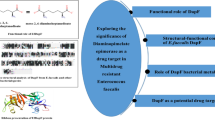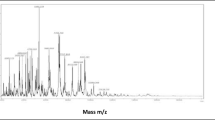Abstract
Klebsiella pneumoniae strain DF12SA (HQ114261) was isolated from diabetic foot wounds. The strain showed resistance against ampicillin, kanamycin, gentamicin, streptomycin, spectinomycin, trimethoprim, tetracycline, meropenem, amikacin, piperacillin/tazobactam, augmentin, co-trimoxazole, carbapenems, penicillins and cefoperazone, and was sensitive to clindamycin. Molecular characterization of the multidrug-resistance phenotype revealed the presence of a class 1 integron containing two genes, a dihydrofolate reductase (DHFR) (PF00186), which confers resistance to trimethoprim; and aminoglycoside adenyltransferase (AadA) (PF01909), which confers resistance to streptomycin and spectinomycin. A class 1 integron in K. pneumoniae containing these two genes was present in eight (18.18 %) out of 44 different diabetic foot ulcer (DFU) patients. Hence, there is a need to develop therapeutics that inhibit growth of multidrug resistant K. pneumoniae in DFU patients and still achieve amputation control. Am attempt was made to create a 3D model and find a suitable inhibitor using an in silico study. Rational drug design/testing requires crystal structures for DHFR and AadA. However, the structures of DHFR and AadA from K. pneumoniae are not available. Modelling was performed using Swiss Model Server and Discovery Studio 3.1. The PDBSum server was used to check stereo chemical properties using Ramachandran plot analysis of modeled structures. Clindamycin was found to be suitable inhibitor of DHFR and AadA. A DockingServer based on Autodock & Mopac was used for docking calculations. The amino acid residues Ser32, Ile46, Glu53, Gln54, Phe57, Thr72, Met76, Val78, Leu79, Ser122, Tyr128, Ile151 in case of DHFR and Phe34, Asp60, Arg63, Gln64, Leu68, Glu87, Thr89, Val90 for AadA were found to be responsible for positioning clindamycin into the active site. The study identifies amino acid residues crucial to ‘DHFR and AadA -drug’ and ‘DHFR and AadA -inhibitor’ interactions that might be useful in the ongoing search for a versatile DHFR and AadA -inhibitor.






Similar content being viewed by others
References
Gadepalli R, Dhawan B, Sreenivas V, Kapil A, Ammini AC, Chaudhry R (2006) A clinico-microbiological study of diabetic foot ulcers in an Indian tertiary care hospital. Diabetes Care 29:1727–1732
Pinzur MS, Slovenkai MP, Trepman E, Shields NN (2005) Guidelines for diabetic foot care: recommendations endorsed by the diabetes committee of the American orthopaedic foot and ankle society. Foot Ankle Int 26:113–119
Lipsky BA, Berendt AR, Deery HG, Embi JM, Joseph WS, Karchmer AW, LeFrock JL, Lew DP, Mader JT, Norden C, Tan JS (2004) Diagnosis and treatment of diabetic foot infections. Clin Infect Diseases 39:885–910
Chincholikar DA, Pal RB (2002) Study of fungal and bacterial infections of the diabetic foot. Indian J Pathol Microbiol 45:15–22
Umadevi S, Kumar S, Joseph NM, Easow JM, Kandhakumari G, Srirangaraj S, Raj S, Stephen S (2011) Microbiological study of diabetic foot infections. Indian J Med Specialit 2:12–17
Kawai T (2006) Hypermucoviscosity: an extremely sticky phenotype of Klebsiella pneumoniae associated with emerging destructive tissue abscess syndrome. Clin Infect Dis 42:1359–1361
Jones ME, Peters E, Weersink AM, Fluit A, Verhoef J (1997) Widespread occurrence of integrons causing multiple antibiotic resistances in bacteria. Lancet 349:1742–1743
El-Najjar NG, Farah MJ, Hashwa FA, Tokajian ST (2010) Antibiotic resistance patterns and sequencing of class I integron from uropathogenic Escherichia coli in Lebanon. Lett Appl Microbiol 51:456–461
Mazel D (2006) Integrons: agents of bacterial evolution. Nat Rev Microbiol 4:608–620
Gebreyes WA, Altier C (2002) Molecular characterization of multidrug-resistant Salmonella enterica subsp. enterica serovar Typhimurium isolates from swine. J Clin Microbiol 40:2813–2822
Holger C, Smith DEC, Blom H, Blau N, Bode H, Holzmann K, Pannicke U, Hopfner KP, Rump EM, Ayric Z, Kohne E, Debatin KM, Smulders Y, Schwarz K (2011) Dihydrofolate reductase deficiency due to a homozygous DHFR mutation causes megaloblastic anemia and cerebral folate deficiency leading to severe neurologic disease. Am Soc Human Genet 88:226–231
Schnell JR, Dyson HJ, Wright PE (2004) Structure, dynamics, and catalytic function of dihydrofolate reductase. Annu Rev Biophys Biomol Struct 33:119–140
Thomas D, Guenter A, Gerd B, Uwe J, Tarmo P, Robert H, Rainer J (2000) The crystal structure of dihydrofolate reductase from Thermotoga maritima: molecular features of thermostability. J Mol Biol 297:659–672
Azucena E, Grapsas I, Mobashery S (1997) Properties of a bifunctional bacterial antibiotic resistance enzyme that catalyzes ATP dependent 2″-phosphorylation and acetyl-CoA dependent 6′-acetylation of aminoglycosides. J Am Chem Soc 119:2317–2318
Ferretti JJ, Gilmore KS, Courvallin P (1986) Nucleotide sequence analysis of the gene specifying the bifunctional 6′-aminoglycoside acetyltransferase 2″-aminoglycoside phosphotransferase enzyme in Streptococcus faecalis and identification and cloning of gene regions specifying the two activities. J Bacteriol 167:631–638
Wagner FW (1981) The dysvascular foot: a system for diagnosis and treatment. Foot Ankle 2:64–122
Bauer AW, Kirby WM, Sherris JC, Turck M (1966) Antibiotic susceptibility testing by a standardized single disk method. Am J Clin Patholo 45:493–496
Clinical and Laboratory Standards Institute (2007) Performance standards for antimicrobial susceptibility testing: Seventeenth informational supplement. Wayne, PA, pp M100–S17
Levesque C, Piche L, Larose C, Roy P (1995) PCR mapping of integrons reveals several novel combinations of resistance genes. Antimicrob Agents Chemother 39:185–191
Solovyev V, Kosarev P, Seledsov I, Vorobyev D (2006) Automatic annotation of eukaryotic genes, pseudogenes and promoters. Genome Biol 7:1–10
Quevillon E, Silventoinen V, Pillai S, Harte N, Mulder N, Apweiler R, Lopez R (2005) InterProScan: protein domains identifier. Nucleic Acids Res 33:116–120
Thompson JD, Higgins DG, Gibson TJ (1994) CLUSTAL W: improving the sensitivity of progressive multiple sequence alignment through sequence weighting, position-specific gap penalties and weight matrix choice. Nucleic Acids Res 22:4673–4680
Tamura K, Dudley J, Nei M, Kumar S (2007) MEGA4: molecular evolutionary genetics analysis (MEGA) software version 4.0. Molecular Biol Evol 24:1596–1599
Bailey TL, Gribskov M (1998) Combining evidence using p-values: application to sequence homology searches. Bioinformatics 14:48–54
Bailey TL, Williams N, Misleh C, Li WW (2006) MEME: discovering and analyzing DNA and protein sequence motifs. Nucleic Acids Res 34:369–373
Gao YD, Huang JF (2011) An extension strategy of Discovery Studio 2.0 for non-bonded interaction energy automatic calculation at the residue level (in Chinese). Zool Res 32:262–266
Arnold K, Bordoli L, Kopp J, Schwede T (2006) The SWISS-MODEL Workspace: a web-based environment for protein structure homology modeling. Bioinformatics 22:195–201
Schwede T, Kopp J, Guex N, Peitsch MC (2003) SWISS-MODEL: an automated protein homology-modeling server. Nucleic Acids Res 31:3381–3385
Laskowski RA, Chistyakov VV, Thornton JM (2005) D266-8 PDBsum more: new summaries and analyses of the known 3D structures of proteins and nucleic acids. Nucleic Acids Res 33:266–268
Maiti R, Van Domselaar GH, Zhang H, Wishart DS (2004) SuperPose: a simple server for sophisticated structural superposition. Nucleic Acids Res 1(2):W590–W594
Bikadi Z, Hazai E (2009) Application of the PM6 semi-empirical method to modeling proteins enhances docking accuracy of AutoDock. J Chem Inf 11:1–15
Solis FJ, Wets RJB (1981) Minimization by random search techniques. Math Operations Res 6:19–30
Morris GM, Goodsell DS, Halliday RS, Huey R, Hart WE, Belew RK, Arthur JO (1998) Automated docking using a Lamarckian genetic algorithm and an empirical binding free energy function. J Comput Chem 19:1639–1662
Rice LB, Sahm D, Bonomo RA (2003) Mechanisms of resistance to antibacterial agents. In: Murray PR, Baron EJ, Pfaller MA, Jorgensen JH, Yolken RH (eds) Manual of clinical microbiology, 8th edn. ASM Press, Washington DC, pp 1074–1101
Lee J, Yennawar NH, Gam J, Benkovic SJ (2010) Kinetic and structural characterization of dihydrofolate reductase from Streptococcus pneumoniae. Biochemistry 49:195–206
She Q, Singh RK, Confalonieri F et al. (2007) Crystal structure of a putative nucleotidyltransferase (AAK41883.1) from Sulfolobus solfataricus at 1.40 Å resolution. Joint Center for Structural Genomics Submitted to the PDB data bank, doi:10.2210/pdb2rff/pdb
Feeney J, Birdsall B, Kovalevskaya NV, Smurnyy YD, Navarro Peran EM, Polshakov VI (2011) NMR structures of apo L. casei dihydrofolate reductase and its complexes with trimethoprim and NADPH: contributions to positive cooperative binding from ligand-induced refolding, conformational changes, and interligand hydrophobic interactions. Biochemistry 50:3609–3620
Cody V, Galitsky N, Rak D, Luft JR, Pangborn W, Queener SF (1999) Ligand-induced conformational changes in the crystal structures of Pneumocystis carinii dihydrofolate reductase complexes with folate and NADP+. Biochemistry 38:4303–4312
Gargaro AR, Soteriou A, Frenkiel TA, Bauer CJ, Birdsall B, Polshakov VI, Barsukov IL, Roberts GC, Feeney J (1998) The solution structure of the complex of Lactobacillus casei dihydrofolate reductase with methotrexate. J Mol Biol 20:119–134
Vidya N, Vadivukkarasi B, Manivannan G, Anbarasu K (2008) Molecular modeling and docking studies of glutamate racemase in Vibrio vulnificus CMCP6. Silico Biol 8:471–483
Pedersen LC, Benning MM, Holden HM (1995) Structural investigation of the antibiotic and ATP-binding sites in kanamycin nucleotidyltransferase. Biochemistry 34:13305–13311
Acknowledgments
S.K.S. is grateful to the Indian Council of Medical Research, New Delhi (India), for the award of Senior Research Fellowship (80/622/2009-ECD-1). This work is partially supported by a research grant sanctioned to A.K. by the Indian Agricultural Research Institute (No. NBAIM/AMAAS/MD (19)/AK/BG), New Delhi. The facilities provided by Department of Biotechnology (DBT)-funded Sub-Distributed Information Centre (SUB-DIC), Centre for Bioinformatics, School of Biotechnology, Banaras Hindu University (BHU), Varanasi, is gratefully acknowledged.
Author information
Authors and Affiliations
Corresponding author
Rights and permissions
About this article
Cite this article
Shahi, S.K., Singh, V.K., Kumar, A. et al. Interaction of dihydrofolate reductase and aminoglycoside adenyltransferase enzyme from Klebsiella pneumoniae multidrug resistant strain DF12SA with clindamycin: a molecular modelling and docking study. J Mol Model 19, 973–983 (2013). https://doi.org/10.1007/s00894-012-1635-5
Received:
Accepted:
Published:
Issue Date:
DOI: https://doi.org/10.1007/s00894-012-1635-5




